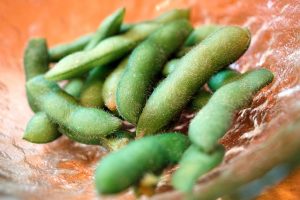Soya
 There has been a lot debate over soya in recent years, but what is the history around it and is the worry over this bean founded? This humble legume has been a staple within Asian cuisine for thousands of years. The soya bean plant is native to China, where it’s been cultivated for well over 13,000 years. Like other beans, the soya bean (Glycine max) grows in pods enclosing the edible seeds. They are usually green but can be yellow, brown or black. The texture is so adaptable that they are frequently processed into a variety of foods. They are known as edamame beans when eaten fresh from the pod and are the basis of soya milk, tofu, miso, tempeh and soya protein.
There has been a lot debate over soya in recent years, but what is the history around it and is the worry over this bean founded? This humble legume has been a staple within Asian cuisine for thousands of years. The soya bean plant is native to China, where it’s been cultivated for well over 13,000 years. Like other beans, the soya bean (Glycine max) grows in pods enclosing the edible seeds. They are usually green but can be yellow, brown or black. The texture is so adaptable that they are frequently processed into a variety of foods. They are known as edamame beans when eaten fresh from the pod and are the basis of soya milk, tofu, miso, tempeh and soya protein.
In comparison to other legumes they are higher in fat and protein and lower in carbohydrates. With over 2,000 soy-related papers being published annually this little bean catches quite some attention.
The vast majority of the world’s soya (75%) is destined for the production of protein-rich animal feed for livestock and it’s this soya that contributes to deforestation rather than the non-GM soya that is grown for human consumption. More than 30 million tonnes of soya are imported into Europe every year purely for livestock and almost all this soya is genetically modified (GMO Compass, 2014). Soya derivatives, such as the emulsifier lecithin, are a key ingredient in many processed foods, many food manufactures have strict policies regarding using non-GM soya, but it’s always best to check the food label.
For humans, soya is a good source of protein so for vegetarians and vegans it’s a winner. They also contain a good source of healthy fats and offer a good source of antioxidants, B vitamins and iron. The health benefits recorded in clinical trials show soya playing a role in heart and bone health, the improvement of menopausal symptoms and studies have also shown it’s benefit in the prevention of cancers such as breast cancer and prostate cancer.
There are many known beneficial nutritional and health qualities of soya but the estrogen-like effects of isoflavones (a type of phytoestrogen) that are in the beans have raised concern. The chemical structure of phytoestrogens is similar to that of human oestrogen but it’s not identical.
The concerns raised have largely been based on animal experiments which suggest that phytoestrogens can affect sexual development and reproduction function. However, with all research papers they have to be observed for bias, ethics and flaws within the study. Isoflavones behave very different in animal’s verses humans, and many of these animals have been exposed to far higher levels of isoflavones that humans can ever be. Within the trials animals are often injected with large amounts of isoflavones which is not in line with how humans ingest and process isoflavones through the digestive system. In fact, isoflavones are estimated to be between 100 and 100,000 times weaker than the oestrogen that occurs naturally within us.
Due to the concerns however, studies have rightly examined issues regarding sexual development or reproductive health and many have concluded no risk. The UK Committee on Toxicity of Chemicals in Food, Consumer Products and the Environment have conducted an in-depth analysis of soya effects on human health (COT, 2003) and acknowledged that there is no evidence that populations which regularly eat high quantities of soya, such as the Chinese and Japanese, have altered sexual development or impaired fertility.
It is thought that phytoestrogens can actually have a normalising and almost balancing effect on the body’s natural oestrogen levels (Kurzer, 2000). A woman who has high oestrogen levels, may benefit from phytoestrogens as it may reduce them by binding to oestrogen receptors and blocking some access from the stronger oestrogens. When oestrogen levels are low (such as in postmenopausal women), the weak effect of phytoestrogens can slightly increase the body’s oestrogen and can relieve menopausal symptoms.
It is interesting to note that there is also concern about the high levels of oestrogen in cow’s milk. Some suggest that it is one of the main ways humans are exposed to oestrogen (Ganmaa and Sato, 2005). When a cow is milked, she is probably pregnant and the milk contains a high level of hormones.
Now I am not saying we should all go out and eat loads of soya and not consider the negative research around it. A lot of research both medical and nutritional can be compromised and we should never stop asking questions. A healthy diet should not contain super high levels of any food including soya – sounds boring and predictable but for the vast majority of us a balanced diet of healthy fats, carbs and protein along with whole foods, fruits and vegetables is the best diet. It is however good practice to know more about the food you eat and the affects it has on your body (good and bad). Everyone is unique and what is good for one is not always good for another. If you are concerned about your consumption of soya (or indeed cow’s milk or anything else) get in touch and I can assess your intake alongside your health history, diet, medications and any medical conditions you may have.
———–